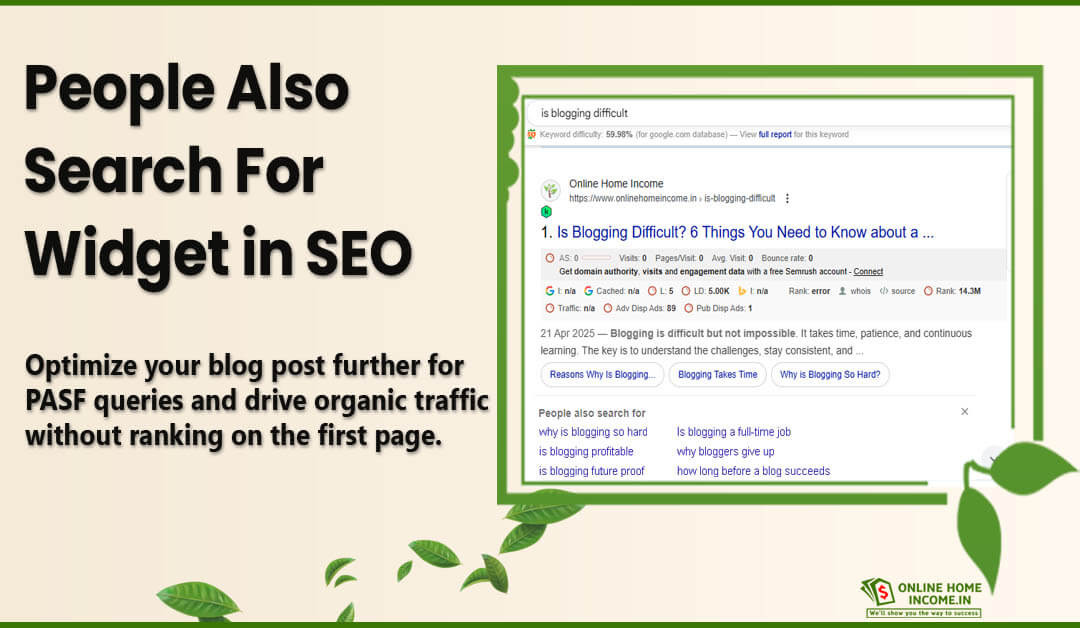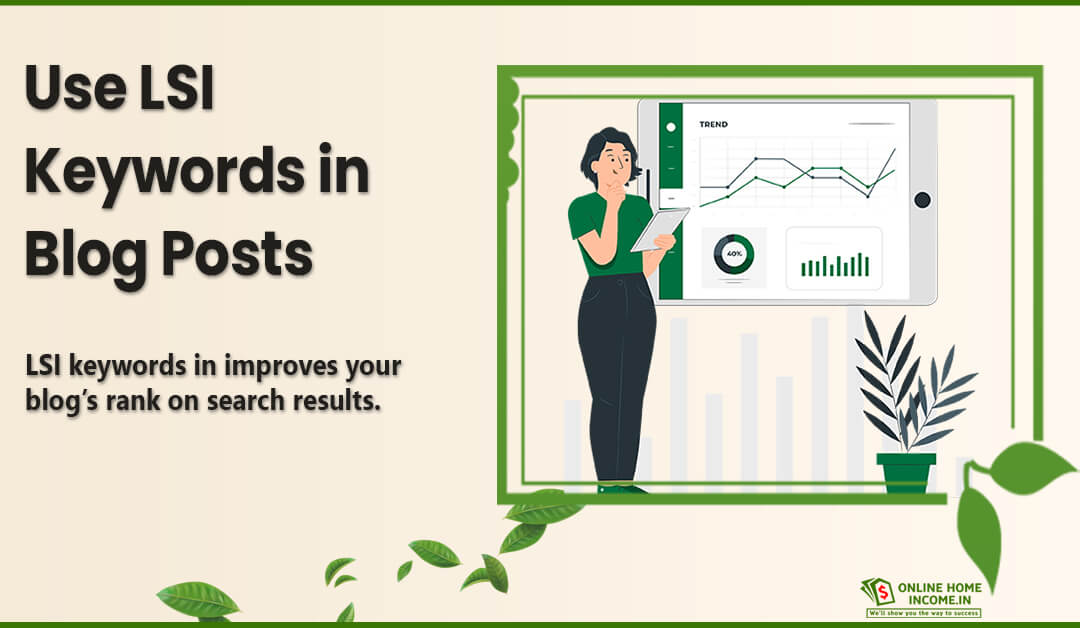Want to know the latest SEO metrics to rank your blog high on search results? Let us learn some SEO trends in blogging that will help increase your blog’s visibility online.
Blogging and earning an income are more challenging than they sound.
Have I not mentioned that anyone can be a blogger?
Yes! However, becoming a top blogger and earning a regular income requires consistent efforts.
Blogging was a restricted hobby in the early days of its inception. However, with the acquisition of Blogger by Google, many people started seeing steady online traffic to their blogs.
Wherever such organic traffic flocks, digital marketing comes into play.
Bloggers started to see steady revenue thanks to ads featured on their blogs. Affiliate marketing, paid partnerships, guest blogging, etc., are a few money-making strategies bloggers adopt.

Before building castles in the air, you must do proper groundwork to set a solid foundation. First and foremost, you must do is attract organic traffic to your blog.
SEO is the most organic way to reach the right audience. Also, it is through SEO-friendly features that your blog gets listed for highly relevant search queries.
Search engines like Google keep updating their SEO algorithms and metrics. Only those blogs that follow these metrics get a spot on the top 10 results or the first page of search results.
We will learn some of the latest SEO trends in blogging from this article. We will also see how you can incorporate them into your blog and increase its visibility online.
Latest SEO Trends in Blogging
Search engines periodically change or upgrade their algorithms to list high-quality search results.
As a result, you may see completely different search results for the same search query at various times.
Have you ever noticed your blog post ranked on top and was replaced by your competitor?
The top rank on SERPs is not eternal. Unless your blog follows the latest SEO trends aligned with the search engine’s filtering algorithms, your blog cannot stay at the top.
Today, learning about AI and its impact on blogs is vital. You must learn to make the best use of AI in creating original content and supporting multimedia for your blogs.
Instead of exact keyword match and indexing, search engines look for semantic relations and relevance of keywords in blogs.
Also, the top search results contain blogs optimized for viewing on mobile devices.
When search engines move their focus to mobile devices, it is also vital to tap a new yet rich feature in these devices: voice support.
Furthermore, blogs that target local audiences and, as a result, increase their local SEO are increasingly visible on search engines.
Also, blogs supported with dedicated videos, like the blogger’s YouTube channel, always find a way to SERPs.
Let us learn about each of these SEO trends in blogging in detail.
1. Impact of AI in Creating Blog Posts
Everyone is aware of the entry of AI into every possible profession today. Blogging is filled with AI and AI tools. These tools become a part of our daily life.
For instance, several tools aid bloggers in every step of blogging.
Tools are available for;
- niche selection – Google Analytics, SEMRUSH
- keyword research – SEMRUSH, Ahrefs, Google Keyword Planner
- title generation – Ahrefs, Copy.ai
- content sub-topic creation – Magical AI, Hints AI
- grammar and spelling check – Grammarly, Hemingway
- multimedia content generation – InShot, Canva
marketing, and so on.
However, some tools generate content itself, say ChatGPT.
In such tools, mentioning the topic generates an entire blog post. Remember that Google algorithms are smart enough to detect AI-generated content.
Such tools are why Google SEO metrics value first-hand experiences and rich, quality blog content for ranking on top search results.
So, can we make use of AI tools or not?
— Yes, you can!
But such tools need to help improve your original blog post and its quality.
Using such tools to do your entire work as a blogger can result in your blog getting a negative SEO score.
So, use AI tools to generate supplementary content for your blog, like rich multimedia images, GIFs, memes, etc.
AI tools to check your text quality are time-saving entities. Furthermore, use suggestions in the various tools and try with your unique combinations.
Remember that original and rich-quality content will only make it to top search results.
2. Long Form Content & Long Tail Keywords
Recent blogging trends show that search engines shortlist blogs with lengthy, engaging, and informational content.
Blogs must have a word count of at least 2500 words without repetition or monotony.
Furthermore, recent studies show that long tail keywords are most sought after by users to locate blog posts. These keywords are more like phrases, containing a minimum of 4-5 words.
Did you know that blogs optimized for long tail keywords have a chance to go above 5-10 ranks on SERPs?
Also, 70% of organic traffic uses long tail keywords to locate what they want exactly.
For instance, a wood-pressed organic coconut oil mill gives more refined and accurate results over a generic query with the same intent as organic oil mills.
Furthermore, 82% of voice searches contain long-form or long-tail keywords.
Long tail search queries better convert organic traffic to your regular followers. These conversions occur because search engines understand user intent based on the long tail keyword.
So make sure that your blogs contain long-tail keywords as focus keywords or secondary keywords to help search engines index your blog sooner.
2.1. How to Find Long-Tail Keywords?
There are various tools and methods to get relevant long-tail keywords for each of your blog posts.
- One easy method is to look for the Google Search auto-suggest feature.
- Typing 2-3 words would list a dropdown menu of complete sentences, which are the long-tail keywords.
- Secondly, People Also Ask lists related and relevant long-tail keywords for any topic.
- Google Keyword Planner is another tool that helps you derive a list of SEO-optimized long-tail keywords.
You can be assured of SEO-friendliness when you search and research for long-tail keywords on Google and its tools.
Some free and paid tools aid in long-tail keyword generation.
SEMRUSH is a popular suite used to find long-tail keywords. Its Keyword Magic Tool helps generate many relevant long-tail keywords in seconds.
If you observe these tools, long-tail keywords have a lower search volume than other top keywords. However, the conversion rates of such keywords are comparatively higher.
3. Impact of Semantic Keywords and Indexing
Observe the top search results for queries these days. They may not necessarily have the exact keywords in the blog or web page.
However, such search results will have the relevant information that a user seeks.
From this inference, we can understand that SEO trends in blogging focus on the semantic indexing of keywords. Such keywords have a similar meaning to those entered by the user.
Earlier search engines would merely look for the exact keywords and their occurrence count to index relevant pages.
Thanks to AI-powered search algorithms, search engines like Google look for the semantic relevance of blogs when matching them with keywords.
For bloggers, you must include a good coverage of semantic keywords to complement your focus keywords.
Google Search uses machine learning algorithms to train its crawlers periodically to read and understand blogs.
With such machine learning algorithms, search engines periodically learn the meanings of new words and link similar words through semantic indexing.
Thus, in the absence of exact matching keywords, blogs that are relevant and contain words with similar meanings and context come to the top of search results.
3.1. What is a Semantic Keyword?
Let us say, I am looking to buy wholesale groceries. I get a list of suggestions like;
- Buy monthly groceries online
- Cheap and Bulk grocery purchases
- Cereals and pulses at wholesale prices
And so on.
If you see the above examples, they are related to the original query in meaning.
- The words bulk and monthly are semantically related to wholesale.
- Similarly, cereals and pulses are related to the word grocery.
In such a manner, search engines look for semantic keywords.
They look for overall content relevance rather than keyword matches alone. There are many tools to search for semantic indexing keywords.
One can start with Google Search Console to learn what keywords users type to reach your page. Learning such relevant words can help refine your blog posts better.
Remember that more than an exact match of primary or semantic keywords, Google looks for the overall UX and first-hand user experiences in your blog post.
If you have quality content that is worth a user’s time, in addition to relevant semantic keywords, your blog has an excellent chance to reach the top.
Let us learn why User Experience (UX) plays a vital role in blog SEO.
4. Optimize the Blog for Mobile Devices
Your blog UX is determined by a few metrics listed under Google Core Web Vitals. Some of these parameters are;
- Largest Contentful Paint (LCP) – this metric refers to the time taken to render the largest element (eg, Image) on the visible area of the blog page.
- First Input Delay (FID) – refers to the time between the user’s touch/input entry and a response from the blog.
- Interaction to next paint (INP) – overall responsiveness and time taken to respond to inputs.
Depending on the calculations and results of the above parameters, you can compare the values with UX performance ranges.
You must strive to improve these scores through responsive UX design.
The latest SEO trend in blogging is to optimize your blogs to run on mobile devices.
You may have a separate mobile-friendly version or scale your website elements to be visible on all screen sizes.
This mobile-first indexing metric ensures that only mobile-friendly blogs reach the top ranks on search results.
By missing out on mobile optimization, your blog loses the chance to rank on top results. So, when designing and deciding your blog elements, include responsive design strategies.
4.1. What do we need to do?
Some tools help to simulate mobile environments and test your blogs.
One such tool is the Google mobile-friendly test tool. This tool shows elements that perform well and areas of improvement in your blog, like;
- Proper and scalable text size
- Portrait and landscape orientation readiness
- Blog responsiveness and speed
- Lazy loading and compression of images
And many more.
All you need to do is enter the URL of your blog in the tool to check for a detailed analysis and report. Yet another tool to check mobile friendliness is the structured data test tool.
Also, Accelerated Mobile Pages (AMP) help to create blog pages that provide lightweight variants of the same page for mobile devices.
With AMP, you can create mobile-friendly WP blogs without knowing much about the technical functionalities.
5. Local SEO in Blogging
Local SEO refers to increasing the visibility of your blog/business online for your local audience.
The best example is businesses with a Google My Business profile. Such online classifieds help users find businesses in their locality or for location-specific queries.
Can we do something similar for blogs?
— Yes, you can!
Blogs are also a business venture. However, your audience does not get to see it that way. People see your blog as a rich source of information.
When your blog has information and tailor-made solutions to suit location-specific or local queries, you are a winner. Moreover, local SEO is a factor of trust and authority.
Business owners and bloggers in Coimbatore who want to boost their local search rankings can discover dedicated strategies by visiting this page on Local SEO Services in Coimbatore.
One of the greatest advantages of local SEO is receiving first-hand feedback from your local audience.
Promote your blog to a localized audience and get their reviews. It is the most organic form of fetching more traffic to your blog.
It is necessary to understand the local audience’s pulse. Research the exact keywords that they use to locate blogs in your niche. Then, you must strategically incorporate these keywords in your blog posts.
5.1. Optimize our Blog for Local SEO
Locality-based keyword research is one of the inescapable SEO trends in blogging today. Go for a tool like Google Keyword Planner to get the best and trending keywords based on locations.
From this research, you can derive a list of keywords and optimize your blogs to include them. Remember that your local keywords must be relevant and not added just for the sake of it.
Use locality-based queries, like ‘near me’, ‘in my area’, ‘best in ‘, etc. Such keywords are highly competitive and attract more traffic. A lot of pages get listed for such queries.
So, if you want your page to stand out for local SEO queries, include a good blend of high-traffic and low-traffic keywords.
In addition to using Google Search, Google Analytics, and People Also Ask, you may use tools like SEMRUSH, Ahrefs, etc., to target local keywords.
6. Voice Search in Blogging
When we discussed optimizing blogs for mobile devices, we must not forget another feature popular in smartphones.
Voice commands and voice support are now a mandatory requirement in all mobile devices.
Voice support is extremely helpful for many online browsers, like those who cannot type on small screens, visually challenged users, etc.
From the mobile point of view, devices get trained for voice recognition and synthesis using AI algorithms.
Furthermore, voice search contributes to 50% of search queries made online. Out of these, 22% are local searches.
Similar keywords of search queries may be pronounced or spelled in different languages and slang.
So, we must ensure that such voice-to-text converted keywords do not let go of organic traffic coming to your blogs.
It is easier to speak than type long search queries. As a result, you can observe that voice search queries are longer, containing long-tail keywords.
No wonder long-tail keywords have higher conversion rates and come from organic traffic sources.
Having voice-based navigation and search features in your blog is a highly desirable SEO trend in blogging.
Many plugins are available to integrate voice support for blogs, especially on mobile devices.
6.1. Let us Optimize our Blog for Voice Search
Besides integrating voice support modules, how do we incorporate this SEO trend to improve blog visibility?
As we saw before, users generally include long-tail keywords or question-like queries. If you add these as your blog post meta title, your SEO score can multiply.
Eg., I want to know how to build a plane using Plaster of Paris.
If you have a blog or tutorial discussing the above, you can use this as your meta title – How to Build a Plane with Plaster of Paris.
If you observe the above case, the meta title relevance and user search intent are a great match.
Consequently, your blog passes the first filters of blog relevance. It can come on the first page of the voice search results.
Voice search also includes such conversation-like queries, which do not happen when typing queries. Users speak to search engines like asking a friend.
If the tone matches this friendly search intent along with relevant content, your SEO score goes up again!
7. SEO Trend in Video
Blogging and blogs get a top spot on search results. There are so many bloggers targeting every possible niche with similar content.
So, to differentiate from the rest and improve their SEO, your best bet is to add accompanying videos to blog posts.
SEO trends in blogging today mandate that every blogger have their own YouTube channel.
We have already seen the need to add accompanying media, like videos to their blogs.
Videos improve visibility and help you reach a wide range of audiences.
Creating and posting YouTube videos is easy and versatile. There are many advantages of using YouTube to improve your blog SEO.
- Videos are supported by Google, and it is SEO-friendly.
- YouTube provides the option to embed video links anywhere.
- Play and render videos within the blog without going to the YouTube app.
- Leverages SEO to list videos for search keywords.
Thus, having a YouTube channel supporting your blog is a win-win situation.
Those who view your videos will come to your blog through a backlink and vice versa. Either way, your organic traffic increases, improving the authority of your blog. As a result, your blog SEO improves.
7.1. Create a YouTube Channel
Starting your own YouTube channel is very simple. Since you have already done most of the research in your blogging niche, you already have the content plan.
All that is needed now is to create supporting images, sliders, and videos, compile them with video editing tools, and upload them to YouTube.
Start Keyword Research – since your videos are meant to supplement your blog posts, it is best to expand your keyword research. Look for hashtags that you can add to your video description.
Create quality videos – videos can be simple images shown as a slideshow, with a voiceover and subtitles.
You can also shoot live videos of you talking and explaining the blog post.
Videos can have animations, recordings, and live sessions with your followers. Videos capturing the latest trends always reach better and faster.
Add Titles and Description – here is a crucial part of adding your focus keywords. For uniformity, keep your blog meta title and YouTube video title the same. Either one can make it to SERPS at a top spot.
Similarly, write a brief explanation of your blog post in the description part, within 140 characters. This place is best to add your focus keywords. Similarly, you can add all possible keyword combinations here as hashtags.
Embed videos in our blog post – finally, you must attach the links to your YouTube video(s) in your blog post. If using WordPress plugins, you may drag and drop the link to embed at the right spot.
Conclusion
From the above topics, you can infer that the latest SEO trends in blogging highly prioritize user experience. Users must be satisfied and crave more when they come to your blog.
Search engines measure and evaluate a blog’s user experience using several metrics before it reaches SERPs for relevant queries.
Search engines have evolved from simply matching documents with keywords to reading the documents and computing relevance scores.
Moreover, thanks to increasing user awareness and voice-based searches, search queries are getting more precise.
This pattern gave rise to many long-tail keywords. Incorporating such keywords in your blog posts improves SEO.
Additionally, bloggers must consider the user devices. We must optimize our blogs with responsive designs to be readable on all devices.
Search engines rank blogs that contain content suited for a particular locality for local search queries. Optimizing your blog with keywords suited for local searches can boost your SEO.
Finally, do not restrict your blog to text alone. Resort to all possible ways to keep your blog at the top. Create YouTube videos, Shorts, Instagram reels, and all possible trending multimedia elements.
Keep tracking search engine algorithm updates and follow our blog to learn the latest SEO trends in blogging.








